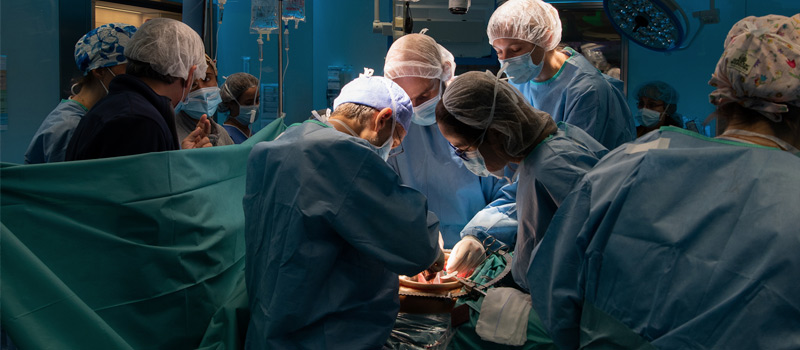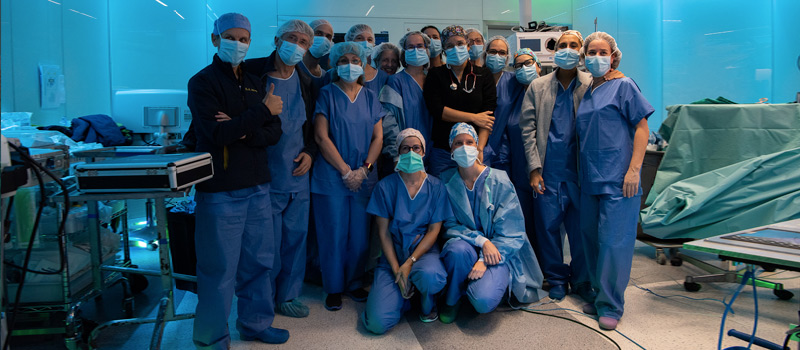11 December, 2020
Hospital Clínic performs the first uterus transplant in Spain

On October 5th, a multidisciplinary team from the Hospital Clínic Group performed the first uterus transplant in Spain. The surgery was led by Dr. Francisco Carmona, head of the Gynecology Service at the Hospital Clínic and gynecological surgeon at barnaclínic+, and Dr. Antonio Alcaraz, head of the Urology and Kidney Transplant Service at the Clínic and urological and transplant surgeon at barnaclínic+ . This first live donor uterus transplant from Spain has been possible thanks to the donation of this organ from one sister to another, who was born without it, and which is known as Rokitansky Syndrome.
The FIRST UTERUS TRANSPLANT: THE RESULT OF A RESEARCH PROJECT
This first living donor uterus transplant in Spain is part of a research project that began five years ago, called “The feasibility study for a living donor uterine transplant procedure obtained by robotic graft”. The main objective of this process was to validate the viability of this surgery. During the research 30 women were considered as candidates, but the only compatible candidate was the patient who was operated on in October. The main requirement for this pioneering intervention is to have Rokitansky Syndrome, a congenital disorder of the female reproductive system characterized by being born without a uterus or fallopian tubes, which affects 1 in every 5,000 women.

The multidisciplinary team responsible for the first uterus transplant in Spain is made up of more than 20 people from the following specialties: gynaecology, transplant surgery, gynaecological and transplant nursing, anaesthesia and nursing assistants.
WHAT DOES A UTERUS TRANSPLANT CONSIST OF?
Uterus transplantation is a highly complex intervention composed of two different phases: first the extraction of the uterus with robotic surgery and then the implantation of the uterus through open surgery. The first phase, as stated by Dr. Antonio Alcaraz, is the most delicate since “the uterus is an organ with poor vascularization of the arteries and a large network of veins, among which we must find the largest ones to drain the blood”. This first phase lasted about 12 hours and was performed by robotic surgery to be as least invasive as possible. The process of implantation with open surgery lasted about 4 hours. The long duration of the intervention, in which more than 20 people from different specialties (gynaecology, transplantation, nursing, anaesthesia) participated, increases its complexity. And, as Dr. Francisco Carmona affirms, the success of the uterus transplant “is determined by the viability of the organ, that it works and that the woman becomes pregnant.”
“The interventions and preparation of the organ were of extreme precision. We were absolutely focused because any failure would spoil the precious organ”
Dr. Antonio Alcaraz in La Vanguardia
Proud to be a Transplant Surgeon! First uterus transplant in Spain at @hospitalclinic. Going beyond Urology, thanks to the collaboration with extraordinary Gynecologist and friend @drfcarmona . Great team! https://t.co/nisVdG4x5s
— Antonio Alcaraz (@AntonioAlcarazA) December 10, 2020
As we have said, currently the requirement to enter the programme and be a candidate for a uterus transplant is to suffer from Rokitansky Syndrome, that is, to have been born without a uterus. However, once the technique is established, it is not ruled out that women who have had to remove the uterus can also access the programme. As Dr. Carmona states, in this project these restrictive criteria have been defined “to demonstrate that the technique is useful. In 15 or 20 years, we may be less restrictive.”
“I think it will become a technique that we can use and will be available to people who do not have a uterus”
Dr. Francisco Carmona in the Diari ARA
Ha sido un orgullo participar en esta intervención quirúrgica que representan un hito histórico en la cirugía del país. Mis felicitaciones al equipo del @hospitalclinic que la hizo posible. Todas las pacientes se beneficiarán de los avances logrados en esta operación https://t.co/mx0cUb5ZDQ
— Dr Francisco Carmona #QuedateEnCasa (@drfcarmona) December 10, 2020
RESULT OF THE FIRST LIVE DONOR UTERUS TRANSPLANT FROM SPAIN
The uterus transplant was a success and both the donor and the recipient are doing well. There has been no rejection and the uterus has started to function. Two months after the operation, the postoperative period has been good and the functionality has been as expected. The recipient has had her first menstrual cycle and it is expected that, in a few months, an embryo from the 11 previously fertilized in vitro can be implanted.
In the event of pregnancy, treatment with immunosuppressive drugs will be maintained. After a second pregnancy, as long as it is your desire for gestation, your uterus will be removed by laparoscopic intervention to prevent complications and interrupt treatment with immunosuppressive drugs.
UTERUS TRANSPLANTATION WORLDWIDE
In 2014, at the Sahlgrenska University Hospital in Sweden, the first birth took place after a live donor uterus transplant. In 2018, at the Hospital das Clínicas de Sao Paulo in Brazil, the first girl was born after a non-live uterus transplant. To date, there have been around 70 uterus transplants worldwide, from which more than 20 children have been born.



